Reduce Food Waste: Smart Tips & Tricks to Save Money
Learn effective ways to reduce food waste with simple meal planning, storage hacks, and creative leftover ideas that help you save money.
Ready to Simplify Your Meal Planning?
Get personalized meal plans and grocery lists automatically matched to your macro targets.
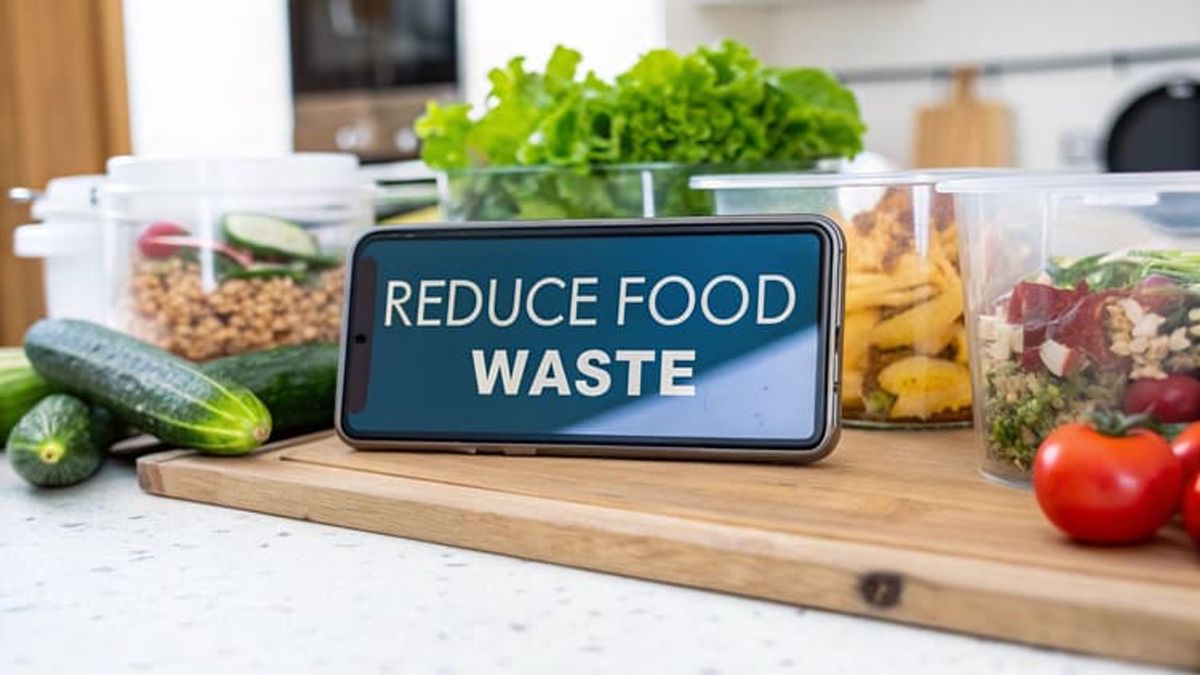
Reduce Food Waste: Smart Tips & Tricks to Save Money
That forgotten bag of slimy spinach and the yogurt playing hide-and-seek in the back of your fridge? It's more than just a minor kitchen bummer. The first real step to reduce food waste is to see it differently—not as a guilt trip, but as a personal, winnable challenge that saves you serious cash and lets you make a real difference, one meal at a time.
Why Your Kitchen Bin Is Costing You Big
Let's get real for a second. We’re not here to drown you in scary global statistics. We’re here to talk about what food waste actually means for your life. It’s the extra trip to the store for that onion you swore you had. It's the beautiful produce you had such high hopes for, now looking sad and wilted. Most of all, it's money that could have been spent on something you actually enjoy.
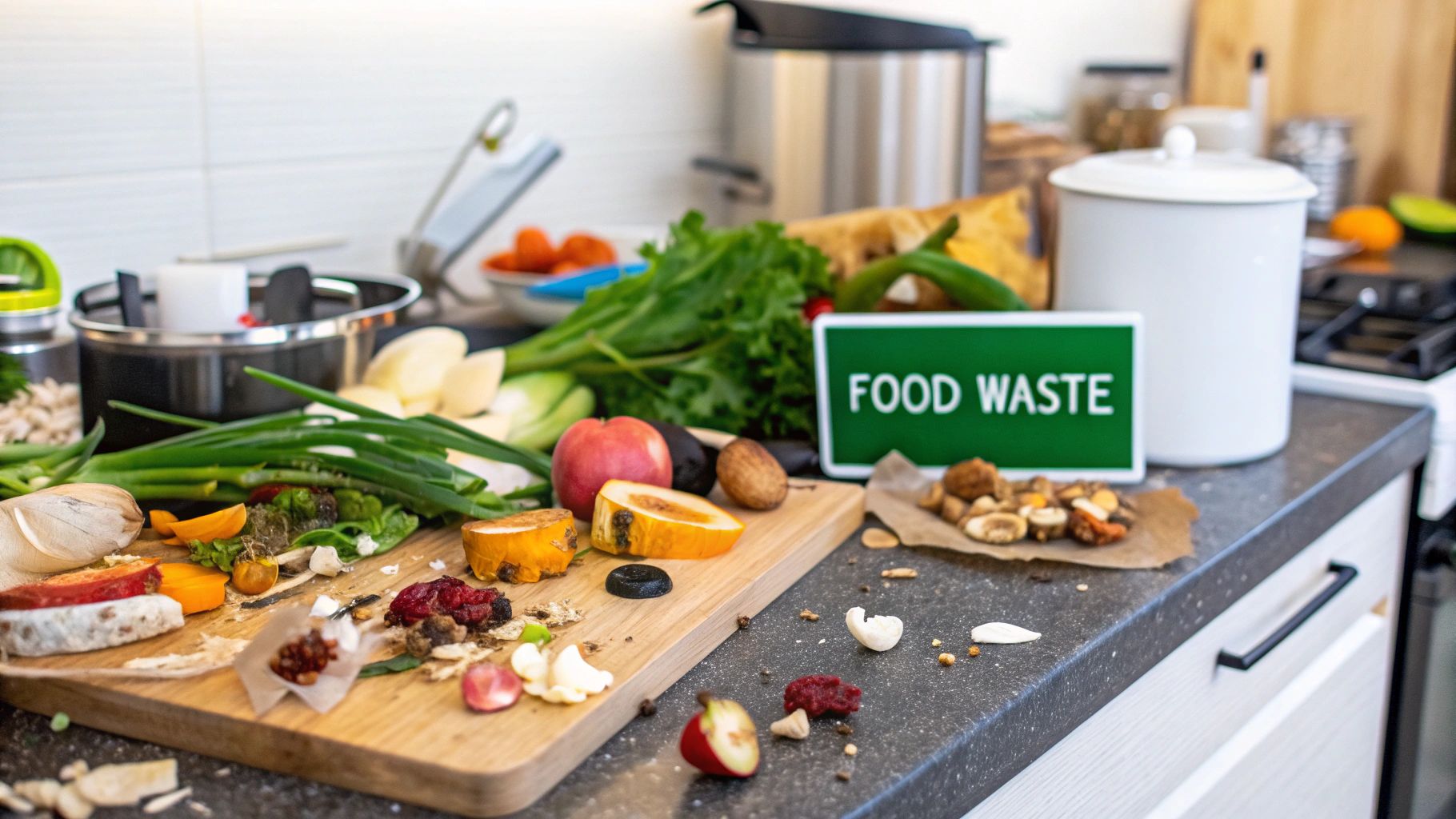
This isn’t about some impossible quest for zero-waste perfection. It’s about realizing the power you hold right there in your own kitchen. Every carrot peel you toss into a bag for future broth or every leftover you reinvent for lunch is a small victory. Trust me, these little wins add up to a huge impact.
The True Cost of Wasted Food
When you toss that half-eaten avocado, you're throwing away more than just a few bucks. You're also discarding all the water, energy, and human effort it took to grow, package, and get it to your counter. When you zoom out, the problem is absolutely massive.
Globally, food waste is a staggering environmental and social issue. In 2022 alone, about 1.05 billion tons of food were wasted while 783 million people faced hunger. The greenhouse gas emissions from all that wasted food are estimated to be nearly five times higher than those from the entire aviation industry. It’s a big deal, and you can find out more about how global food waste affects the planet.
The average American family can save a surprising amount of money each year just by tweaking their shopping and cooking habits. Think of it as finding an extra paycheck hiding in your pantry.
A Winnable Challenge for Your Home
Instead of getting bogged down by the problem, let's focus on the solution—which, believe it or not, can be pretty fun and rewarding. You don’t need to completely overhaul your life overnight. The goal is to build small, smart habits that actually stick. Throughout this guide, we'll walk you through simple, actionable strategies that prove you can slash your food waste without adding more stress to your plate.
Here’s what this simple shift in mindset can do for you:
- Save Money: You'll buy only what you need and use everything you buy. That frees up cash for things you really want.
- Eat Better: With a little planning, you’ll find yourself eating fresher, more interesting, and downright tastier meals.
- Reduce Stress: A well-managed kitchen just feels better. It brings a sense of calm and control to the daily chaos of mealtimes.
Ready to turn your kitchen into a hub of delicious efficiency? Let’s dive in.
Win the War on Waste Before You Even Leave the House
Let’s be honest, the battle against food waste isn't won in the grocery store aisle. It’s won right in your own kitchen, with a dash of clever planning. This is where we stop treating meal planning like a dreaded chore and start seeing it for what it is: your secret weapon for saving serious cash.
Forget those rigid, complicated meal plans that completely unravel by Tuesday night. We're going for something more flexible, a "Meal Flow" that starts with what you've already got.
The first move is simple but powerful: shop your kitchen first. Seriously. Before you even dream of writing a grocery list, take a quick peek in your fridge, freezer, and pantry. What's hanging around? That half-bunch of wilting cilantro, the lonely sweet potato rolling around in the drawer, those chicken breasts you tossed in the freezer last week—these are your star players. This "use-it-up" inventory is the bedrock of your entire plan.
This is the all-too-common journey from good intentions to a full trash can.
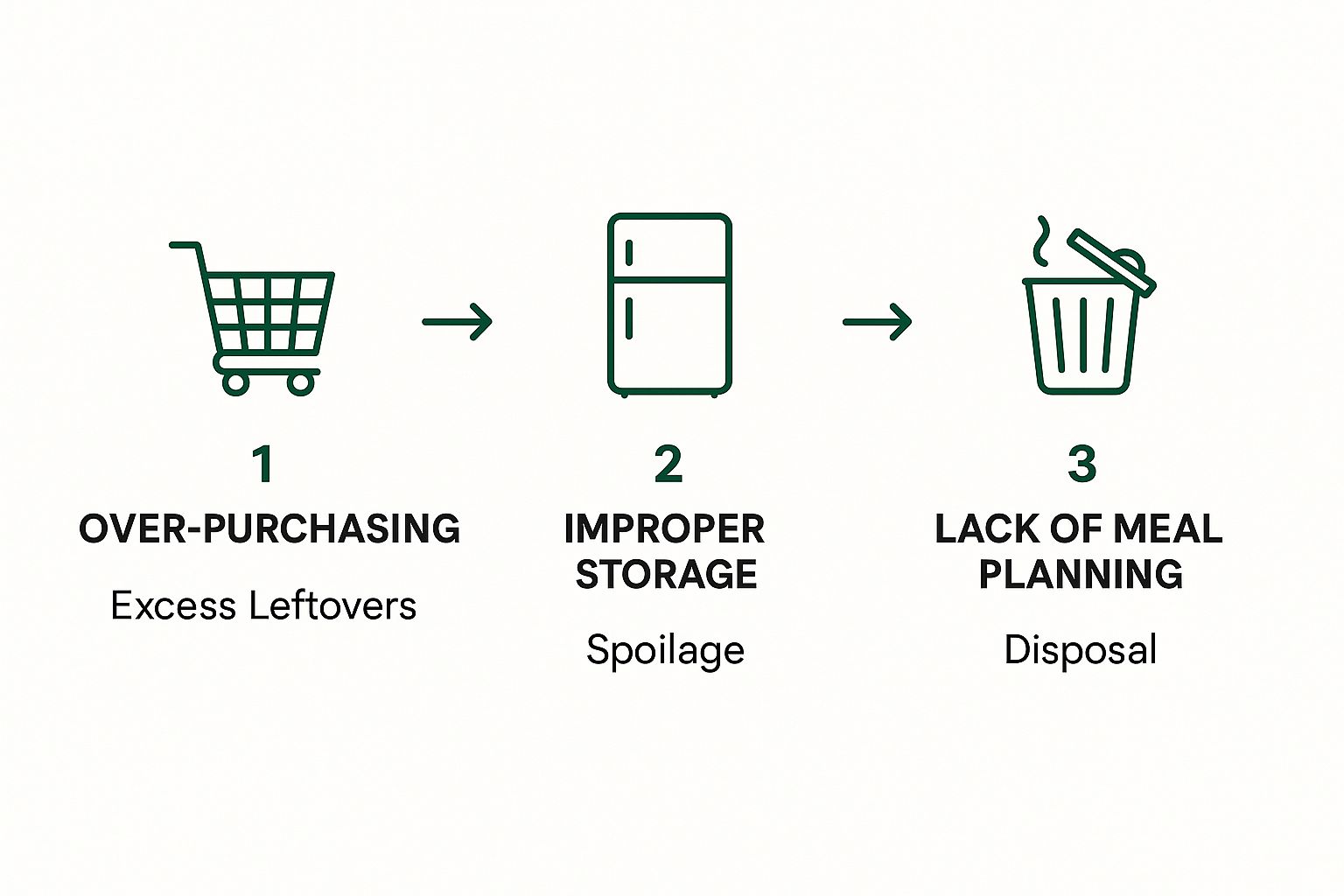
As you can see, jumping straight to the store without a plan is a one-way ticket to buying too much. That’s the cycle we’re here to break.
Create Your "Meal Flow"
Alright, time to get creative. The goal is to stop seeing ingredients as one-trick ponies and start viewing them as versatile building blocks. Let's say your kitchen inventory dig turns up some chicken, a couple of bell peppers, and an onion. Don't just plan a single meal—think about how you can make those core ingredients work for you all week long.
Here’s what that looks like in action:
- Night 1: Sizzling chicken fajitas. You'll use some of the chicken, peppers, and onions. Grab some tortillas and salsa. Easy.
- Night 2: A quick chicken and veggie stir-fry over rice. Use up more of that core trio.
- Night 3: A simple sheet-pan roast with the last of the chicken and peppers, maybe tossed with some potatoes you already had.
See the difference? You’re not just planning dinners; you're mapping out an intelligent flow of ingredients from one meal to the next. This is what keeps you from mindlessly tossing extra stuff into your cart.
The most effective way to reduce food waste is to prevent it from entering your home in the first place. Every item you don't buy unnecessarily is a 100% win for your wallet and the planet.
Let Tech Do the Heavy Lifting for You
Now, I know this sounds like a lot of mental gymnastics, but this is where modern tools can be a game-changer. Instead of scratching your head and scribbling on a notepad, you can use a clever partner like Meal Flow AI.
Just plug in your "use-it-up" ingredients—the chicken, peppers, and onions from our example—and let it work its magic. It will spit out a bunch of recipe ideas and, more importantly, a shopping list for only the extra things you need to complete the meals.
This completely flips the script on traditional meal planning. You're starting with what you own, guaranteeing that sad-looking bag of spinach doesn't get forgotten and turn to slime in the back of your fridge.
To show you just how this works, here's a table that turns a few leftover veggies into a week's worth of dinner ideas.
From Leftover Veggies to Weeknight Dinners
| Available Ingredient | Meal Idea 1 | Meal Idea 2 | Shopping List Add-on |
| Half a head of cabbage | "Egg Roll in a Bowl" with ground pork/tofu | Crunchy slaw for fish tacos | Ground pork, ginger, soy sauce |
| A few sad carrots | Roasted with honey and thyme as a side | Shredded into a quick carrot-ginger soup | Fresh thyme, ginger, coconut milk |
| Leftover roasted potatoes | Crispy breakfast hash with fried eggs | Cheesy potato and broccoli bake | Eggs, cheddar cheese, broccoli |
| Half a can of coconut milk | Base for a simple Thai green curry | Added to a smoothie for creaminess | Green curry paste, chicken/tofu |
This is the Meal Flow concept in a nutshell—connecting what you have to what you'll make, so your shopping list is short, smart, and targeted.
The result? A hyper-focused, waste-free shopping trip. It's a simple habit, but an average family can save thousands of dollars a year with this approach. You'll find yourself buying less, eating better, and finally feeling like you're in control of your kitchen. It's the ultimate strategy to reduce food waste where it really counts.
Become a Food Storage Master
Alright, let's talk about what happens after you get home from the store. You can have the best meal plan in the world, but if your food goes bad before you can use it, you're right back where you started. Think of your fridge and pantry less like chaotic storage closets and more like life-support systems for your groceries.
Getting this part right is a game-changer. Proper storage can easily add days—sometimes even weeks—to the life of your food. That means more flavor, less waste, and fewer last-minute trips to the store.
Let’s start with a classic kitchen tragedy: sad, wilted herbs. We've all been there. You buy a beautiful bunch of cilantro, and two days later it's a slimy mess. Here’s the fix: treat soft herbs like cilantro, parsley, and mint like a bouquet of fresh flowers. Snip the ends, pop them in a jar with a bit of water, and they'll stay vibrant for so much longer. For woody herbs like rosemary and thyme, just wrap them in a slightly damp paper towel before putting them in the fridge. Easy.
Your Fridge Is Not a Free-for-All
A well-organized fridge is your secret weapon against spoilage. Most of us just cram things in wherever they fit, but different zones in your fridge have very different temperatures and humidity levels.
For instance, that fridge door? It’s the warmest part of your fridge. It's fine for condiments, which are loaded with preservatives, but it’s a terrible place for milk and eggs. They need the consistent cold of a main shelf.
Here are a few other common storage mistakes I see all the time:
- Mind the bad apples: Seriously. Fruits like apples, bananas, and even tomatoes release something called ethylene gas as they ripen. It's totally natural, but it's a nightmare for your other produce. Keep these ethylene-producers away from sensitive veggies like leafy greens, broccoli, and carrots, or you'll watch them wilt in record time.
- Give your berries a bath: Want to stop your berries from turning into a fuzzy science experiment overnight? Give them a quick rinse in a solution of one part vinegar to three parts water. Pat them completely dry (this is key!) before popping them in a breathable container in the fridge. This little trick works wonders.
- Bread belongs on the counter, not in the cold: Putting bread in the refrigerator actually makes it go stale faster. Weird, right? Keep it in a bread box or just on the counter in a cool, dry spot. If you know you won't finish a loaf in a few days, slice it up and toss it in the freezer. You can toast a slice straight from frozen, and it's perfect every time.
Implement the "Eat Me First" System
This is one of the single most effective habits I've ever adopted in my own kitchen. I have a clear, designated "Eat Me First" bin right at eye level in my fridge.
What goes in it? Anything that's on the clock. Leftover chicken from last night, half a bell pepper, that container of yogurt nearing its expiration date—it all goes in the box.
It's such a simple visual cue, but it completely eliminates the guesswork. Before I even think about what to cook or grab for a snack, I check the box first. It's the same First-In, First-Out (FIFO) system professional kitchens use, and it's brutally effective at home.
This tiny change has a huge ripple effect. When we stop perfectly good food from getting lost in the back of the fridge, we're making a real dent in a massive problem. In the U.S., food waste made up a staggering 24% of all landfill material back in 2018. The good news? Smarter storage and a simple "Eat Me First" box are powerful ways to fight back, starting right in your own kitchen. You can learn more about the impact of U.S. food waste on our environment and see just how big of a difference we can make.
Give Your Leftovers a Second Life
Alright, let's make a pact. We're officially killing the word "leftovers." It sounds so sad and forgotten, doesn't it? From now on, let's call them what they really are: pre-cooked ingredients, just waiting for their moment to shine. Getting your head around this simple idea is the secret to unlocking a whole new world of creative, waste-free cooking. It's time to ditch the depressing, nuked-in-the-microwave plate of yesterday's dinner.
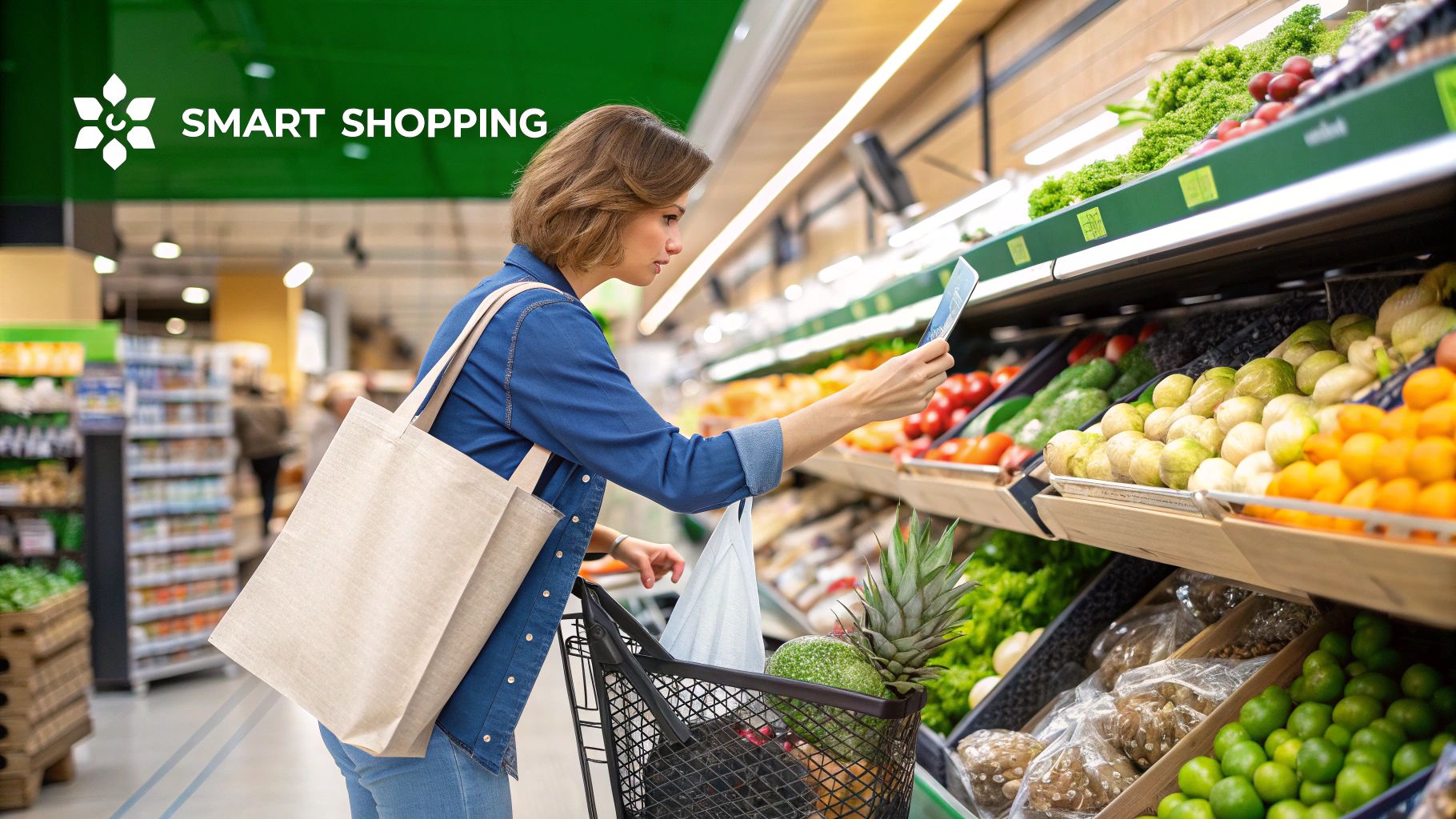
Honestly, this mindset shift is everything. That half-eaten roasted chicken isn't a problem to solve; it's the hero of tomorrow's creamy chicken salad sandwiches, a soul-warming noodle soup, or a bubbling pasta bake. Those bell peppers looking a little soft in the crisper drawer? They are practically begging to be blitzed into a zesty romesco sauce or roasted into a savory side dish.
Giving your food a second act is one of the most satisfying ways to reduce food waste. Why? Because it feels like you're getting a delicious, brand-new meal for free.
The Art of the Remix
The real trick to becoming a master of repurposing is to stop seeing the original dish and start seeing its core components. Take a classic Sunday roast, for example. What you have is cooked meat, roasted vegetables, and maybe some leftover gravy. Instead of just reheating a slab of it on a plate, let's break it down.
- The Protein: Shred that leftover beef or chicken! It's now the perfect filling for tacos, quesadillas, or a killer topping for a loaded baked potato.
- The Veggies: Roughly chop those roasted carrots and potatoes and toss them into a frittata. You could also blend them with some stock to start a creamy soup or mix them into a hearty grain bowl.
- The Sauce: Don't you dare throw out that gravy. Thin it out with a little broth to create a base for a new stew, or simply use it to add a massive flavor boost to a pot of rice.
This "remix" approach keeps things interesting, preventing that dreaded meal fatigue. It turns using every last scrap from a chore into a fun culinary puzzle.
It's a bit shocking, but a study in Oregon found that a whopping 71 percent of food that households throw away could have actually been eaten. Just think of all the amazing meals hiding in that statistic!
Your Creative Partner in the Kitchen
Look, even the most seasoned home cooks get stumped. We've all been there—staring into the fridge at a random assortment of things. A scoop of rice, half a can of black beans, some cooked broccoli, and a lone sausage. What on earth do you do with that?
This is where having a little help can be a game-changer. Using a tool like Meal Flow AI is like having a creative chef whispering brilliant ideas in your ear. You can literally tell it the exact ingredients you have, and it will dream up recipes that pull them all together. That weird collection of yours? It might suggest a savory sausage and broccoli fried rice or a hearty bean and sausage skillet.
It completely takes the mental load off your shoulders and makes sure no good ingredient gets left behind. It's a simple, surprisingly effective way to turn what could have been waste into an exciting new meal, making your kitchen adventures both delicious and incredibly efficient.
Use Smart Tech to Fight Food Waste
Let's be honest, fighting food waste in our own kitchens can feel like a constant battle. We all have good intentions, but life gets busy. That's where having a secret weapon in your pocket comes in handy. I'm not talking about those basic note-taking apps that are just a digital version of your scribbled-on-the-back-of-an-envelope grocery list. We're talking about bringing in some real backup—a personal kitchen assistant powered by smart tech.
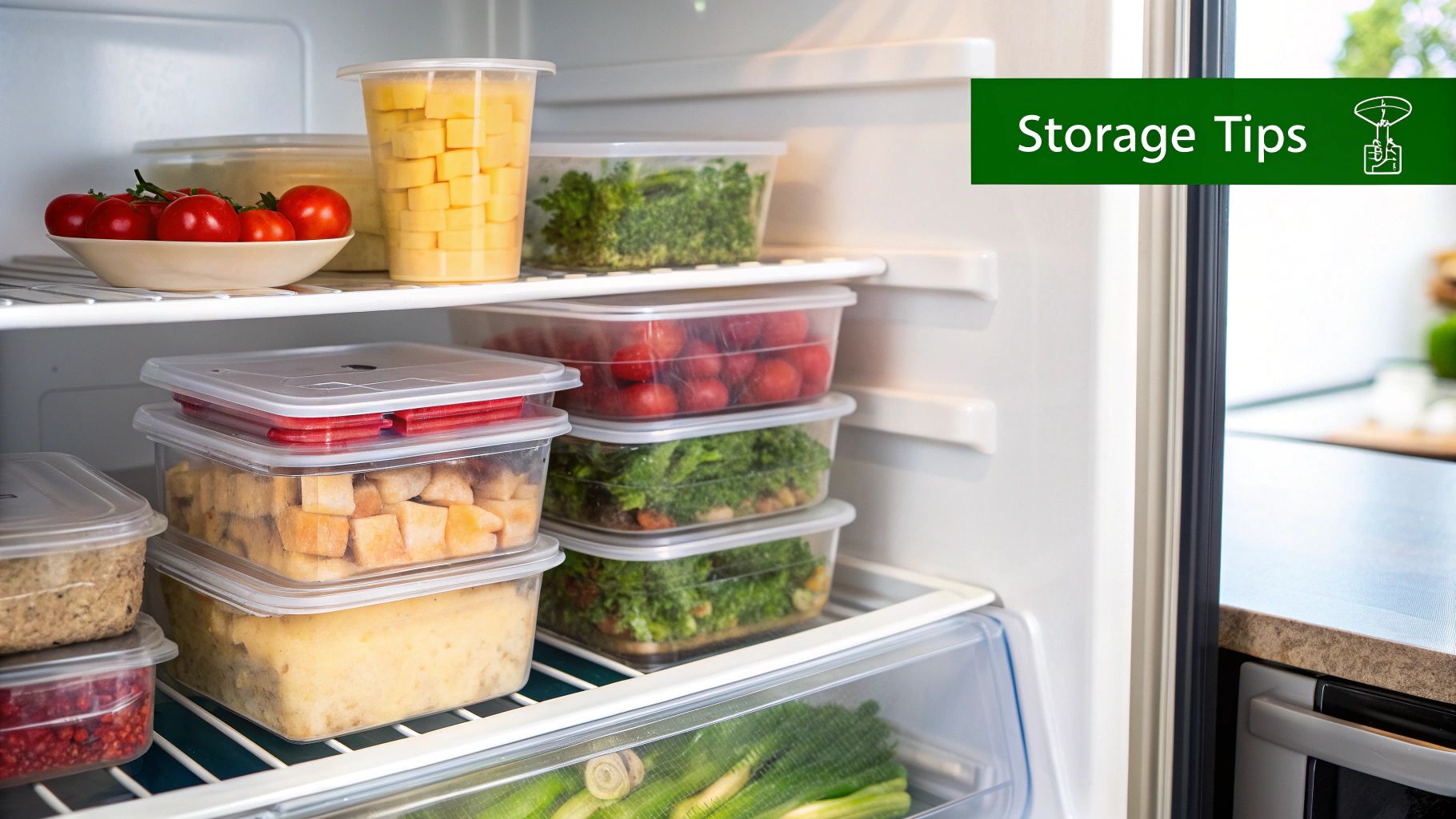
Picture this: an app that doesn't just know what's in your pantry but also nudges you when that block of cheese is about to turn into a science experiment, complete with tasty recipe ideas to use it up. This isn't some far-off futuristic concept anymore. It's a real-deal way to save time, dial down the dinner-time stress, and make your kitchen run like a well-oiled machine.
Your Personal Kitchen Assistant
Think about all the brainpower that goes into just managing your food. What’s for dinner tonight? What do I need from the store? Do I have cumin, or did I use the last of it? This is exactly the kind of mental load that AI-powered apps like Meal Flow AI are built to take off your plate.
The whole process is surprisingly simple but incredibly clever. You can snap a quick photo of what's in your fridge or punch in your pantry items manually. Then the AI magic happens. It instantly scans your inventory and matches it against a massive database of recipes.
Suddenly, the dreaded "what's for dinner?" question just... disappears. That random assortment of a bell pepper, half an onion, and some leftover chicken is transformed into a concrete plan, with a shopping list for the one or two things you might be missing.
This tech-first approach cuts food waste at its source: impulse buys and forgotten food. When you walk into the grocery store with a precise, AI-generated list, you’re way less likely to wander the aisles tossing random things into your cart.
By connecting the dots between what you already have and what you actually need, these tools make using ingredients before they spoil practically effortless. It's a simple, proactive strategy that keeps food on your plate and cash in your pocket.
And let's be real, this matters now more than ever. Despite all the talk about reducing waste, the numbers are still staggering. In 2023, surplus food in the U.S. ballooned to 73.9 million tons, with a jaw-dropping price tag of around $382 billion. The environmental cost is just as massive, producing greenhouse gas emissions on par with 54 million cars. If you want to dive deeper into the data, check out the latest findings in ReFED's report on U.S. food waste.
Turning Kitchen Chaos into Calm
At the end of the day, using smart tech is about more than just stats and efficiency. It’s about getting your sanity back. That low-grade, humming anxiety from managing groceries, planning meals, and dealing with waste is genuinely draining. Automating that grunt work lets you get back to the fun parts of cooking.
Here's what that actually looks like in real life:
- No more last-minute "emergency" trips to the store because you forgot the sour cream.
- Less of that sinking feeling when you discover a bag of slimy spinach in the crisper drawer.
- A jolt of creativity as the app suggests new recipes you'd never have dreamed up on your own.
By letting an app handle the heavy lifting, you're not just being more efficient—you're being kinder to your future self. It’s the easiest way to turn a chaotic kitchen into a calm, waste-fighting command center.
Got Food Waste Questions? We've Got Answers.
Alright, let's be real. Even with the best intentions, building new habits can be tricky. Little questions pop up, you hit a snag, and suddenly that goal to reduce food waste feels like a chore. The secret to sticking with it? Getting quick, no-nonsense answers when you're in a pinch.
So, let's dive into some of the most common head-scratchers that can throw you off your game. Think of this as your personal cheat sheet for those "what do I do with...?" moments.
"I'm Overwhelmed. Where Do I Even Start?"
This is the big one. What's the absolute simplest, most impactful first step you can take?
Just do a "fridge audit." Seriously, that’s it. Before you even dream of writing a grocery list, pop open your fridge and take a quick look around. See what you've got, and pay close attention to anything that's waving a little "eat me soon!" flag.
This tiny habit creates a massive domino effect. You'll automatically start planning your first few meals around what needs to be used up. That means no more buying a second head of broccoli when you already have one wilting in the crisper. It’s a five-minute task that immediately puts money back in your pocket and food on your plate.
"Help! My Family is So Picky."
How can you possibly avoid waste when you're catering to a crew of fussy eaters?
I've been there. The secret weapon is deconstruction. Instead of serving a finished, all-in-one dish like a casserole, lay out the ingredients and let everyone build their own meal. It's a game-changer.
- Taco Night: Don't pre-fill the shells! Set up a station with bowls of seasoned meat, lettuce, tomatoes, cheese, and salsas. Everyone becomes their own taco artist.
- Pasta Night: Serve the plain pasta with a couple of sauces on the side. Add bowls of roasted veggies, grilled chicken, or meatballs. Control is key!
- Grain Bowls: Lay out a base (quinoa or rice is great) and a buffet of toppings: black beans, roasted sweet potatoes, fresh greens, and a simple dressing.
This "build-your-own" strategy gives everyone the power to choose what goes on their plate, which means they're far more likely to clean it. Plus, the leftovers are a dream to work with. A bit of plain chicken is way more versatile than a scoop of mystery casserole.
"What About Scraps I Can't Eat?"
Are some food bits just destined for the compost bin?
While some scraps are truly, well, scraps, you would be absolutely shocked at what you can rescue from the bin. Many of the bits and bobs we toss without a second thought are hiding a second, surprisingly delicious life.
The trick is to stop seeing scraps as trash and start seeing them as a "flavor bonus." That freezer bag of veggie peels and onion ends cost you nothing, but it’s the secret to a rich, complex broth that will make your next soup taste like it came from a five-star restaurant.
Keep a big, labeled bag in your freezer and start your collection. You'll be amazed at what you can save.
- Onion and garlic skins
- Carrot peels and ends
- Celery butts and leaves
- Stems from parsley or cilantro
- Mushroom stems
- Corn cobs (after you've cut off the kernels)
Once the bag is full, just dump the frozen contents into a pot, cover with water, and let it simmer for an hour or two. Strain it, and voilà! You've just made incredible vegetable broth for free. Other scraps have cool uses, too—coffee grounds are gold for garden soil, and citrus peels can be candied or used to make a fantastic all-purpose cleaner.
---
Ready to make all of this ridiculously easy? Meal Flow AI takes the mental load out of meal planning, helps you use up what you've got, and generates perfect shopping lists every single time. Discover how Meal Flow AI can transform your kitchen and help you reduce food waste today!